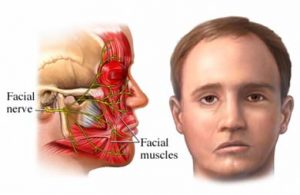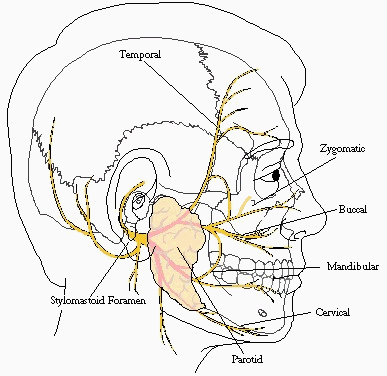Local Anesthesia can produce quite a few complications, that can include the blood vessels and nerves in the areas that were included or targeted during the Dental Anesthesia Administration. The Neurological Symptoms that are seen as complications due to Local Anesthesia include Facial Nerve Paralysis and the Visual Disturbances like Squint, Diplopia, Transient Amaurosis and even Permanent blindness. Below is what we call Facial Nerve Paralysis and Paresis, affecting the Facial Nerve that has got a lot of supply to the facial regions.
Read below for the various aspects of Facial Nerve Paralysis due to LA:
- Branches of Facial Nerve
- Cause of Facial Nerve Paralysis
- Problems due to Facial Nerve Paralysis
- Prevention of Facial Nerve Paralysis
- Management of Facial Nerve Paralysis
 Facial nerve is the seventh cranial nerve, which carries the motor impulses to the various muscles responsible for the facial expression, the scalp and external ear. Facial Nerve Paralysis mainly is caused due to the introduction of the Local anesthetic into the capsule of the parotid gland. Paralysis is also sometimes associated by the the muscle drooping, observed with the lip muscles. To understand how and which areas are anesthetized, and which are paralyzed, read below for the various branches and the muscles that are innervated by the Facial Nerve:
Facial nerve is the seventh cranial nerve, which carries the motor impulses to the various muscles responsible for the facial expression, the scalp and external ear. Facial Nerve Paralysis mainly is caused due to the introduction of the Local anesthetic into the capsule of the parotid gland. Paralysis is also sometimes associated by the the muscle drooping, observed with the lip muscles. To understand how and which areas are anesthetized, and which are paralyzed, read below for the various branches and the muscles that are innervated by the Facial Nerve:
Facial Nerve Branches and Muscles Innervated by them
- 1. Temporal branches
- Frontalis
- Orbicularis oculi
- Corrugator supercilii
- 2. Zygomatic branches
- Orbicularis oculi
- 3. Buccal branches: supplying the region inferior to the eye and around the mouth
- Procerus
- Zygomaticus
- Levator labii superioris
- Buccinator
- Orbicularis oris
- 4. Mandibular branch: supplying muscles of the lower lip and chin
- Depressor anguli oris
- Depressor labii inferioris
- Mentalis
Cause of Facial Nerve Paralysis
The Parotid Gland is present at the posterior border of Ramus of the Mandible, and is covered by the Masseter and the Medial Pterygoid muscles. Introduction of the Local Anesthetic into the Parotid gland can lead to the Transient Facial Nerve Paralysis. While administering the Inferior Alveolar Nerve Block, if the needle is directed in a posterior direction or is overinserted during other blocks like Vazirani-Akinosi nerve block, this may see the needle tip into the body of the Parotid gland. If unknowingly the Dentist deposits the Local Anesthesia, the transient paralysis of the Facial nerve can occur for the same time as it is for a soft-tissue anesthesia.
Problems due to Facial Nerve Paralysis
Due to the deposition of LA into the parotid gland, there is loss of motor function to the muscles of facial expression and this is transitory, lasting no more than a few hours. There is rarely any sensory loss seen, and during this time the unilateral paralysis of muscles is seen. The patient will not be able to voluntarily close one eye, and the the protective lid reflex is lost for that certain time. There is no response from the eye, except the corneal response which produces the tears when there is any irritation to the eyes.
How to Prevent Facial Nerve Paralysis
Prevention should be done by following the normal protocol of the LA administration, like when the Inferior Alveolar Nerve Block is being given, do check that the tip of the needle is touching the bone, which would preclude the possibility that the solution will be deposited in the parotid gland. If at all the needle doesn’t contact the bone or has gone further posteriorly, it is better to withdraw the needle until the superficial tissues are reached, and again progress to reach the bone.
In the Vazirani-Akinosi nerve block, the overinsertion of the needle should be avoided. For the normal adult, it should not exceed 25mm of penetration.
Management of Facial Nerve Paralysis
After the deposition of the local anesthesia solution, within a few seconds to minutes the affects of the complication can be seen, as the muscles on the affected side of the face get weakened. Following are the steps for the management of the Facial Nerve Paralysis:
- Firstly reassure the patient, and explain to them that the effects they are seeing will last for a few hours and will subside then leaving no residual effect. Let them know the prime cause, that this is a reaction to the local anesthetic solution by the Facial nerve.
- If at all the patient is having contact lenses for the vision, it should be removed until the muscular movements return back.
- Try to apply an eye patch and if that is not possible, ask the patient to close the eye periodically using the lower eye lid manually so that the cornea is kept lubricated.
- Do not carry on with the Dental treatment on this particular appointment, though this is not a particular contraindication.

I had facial nerve paralysis
After the dental hygienist gave me
my local. It was very scary and it did
go away after a couple hours.
What r the chances of it happening
Again
I got but should up a week later and has lasted 3 weeks. What should i do?
What are chances of the motor responses not coming back to normal after a couple hours? How should we manage it?
Hi,
After a year of my implant surgery, my lower lip ( left side only) is still numb. Right side returned to normal after 4 months, but left side continues. When I touch this numb part with my fingers it has strange sensation. Is there any possible help for me.Is there antidote for Novocain? Would it help in my case.
After a molar filling and the preceeding anaesthesic injection I still have a downturned mouth on that one side 18months later. No one is able to help with what has actually happened